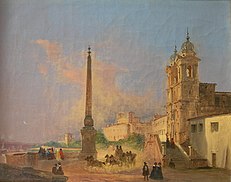Ippolito Caffi
- Machine translation, like DeepL or Google Translate, is a useful starting point for translations, but translators must revise errors as necessary and confirm that the translation is accurate, rather than simply copy-pasting machine-translated text into the English Wikipedia.
- Do not translate text that appears unreliable or low-quality. If possible, verify the text with references provided in the foreign-language article.
- You must provide copyright attribution in the edit summary accompanying your translation by providing an interlanguage link to the source of your translation. A model attribution edit summary is
Content in this edit is translated from the existing Italian Wikipedia article at [[:it:Ippolito Caffi]]; see its history for attribution. - You may also add the template
{{Translated|it|Ippolito Caffi}}to the talk page. - For more guidance, see Wikipedia:Translation.


Ippolito Caffi (1809–1866) was an Italian painter of architectural subjects and seascapes or urban vedute.
Biography
He was born at Belluno. His first works were produced at the Academy of Fine Arts of Venice. By 1830, he had won awards for his vedute at the academy. He subsequently moved to Rome, made some reputation by his treatise on perspective, as well as by his investigations on Roman archaeology. In 1843 he visited Greece and the East (Athens, Constantinople, Syria, Egypt, and Malta).[1] The first work of his that created a sensation was Carnival at Venice. This was exhibited at Paris in 1846, and was admired for its brilliant effects of light. Other works are his Panorama of Rome from Monte Mario, Isthmus of Suez, and Close of the Carnival at Rome. He joined revolutionary movements in Venice in 1848, and had to retire into Piedmont. His aim of commemorating in paint the first Italian naval engagement was frustrated when the Re d' Italia, on which he travelled, was destroyed on 20 July 1866 by the Austro-Venetian fleet at the battle of Lissa, drowning him along with his comrades.
In 2005–2006, an exhibition on Ippolito Caffi was held in his native Belluno.[2]
References
- Bryan, Michael (1886). Robert Edmund Graves (ed.). Dictionary of Painters and Engravers, Biographical and Critical. Vol. I: A-K. London: George Bell and Sons. p. 208.
External links
 Media related to Ippolito Caffi at Wikimedia Commons
Media related to Ippolito Caffi at Wikimedia Commons
- v
- t
- e











